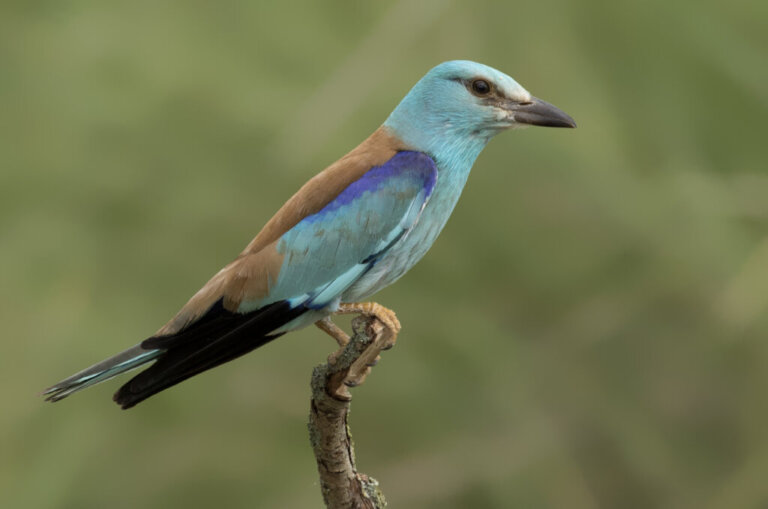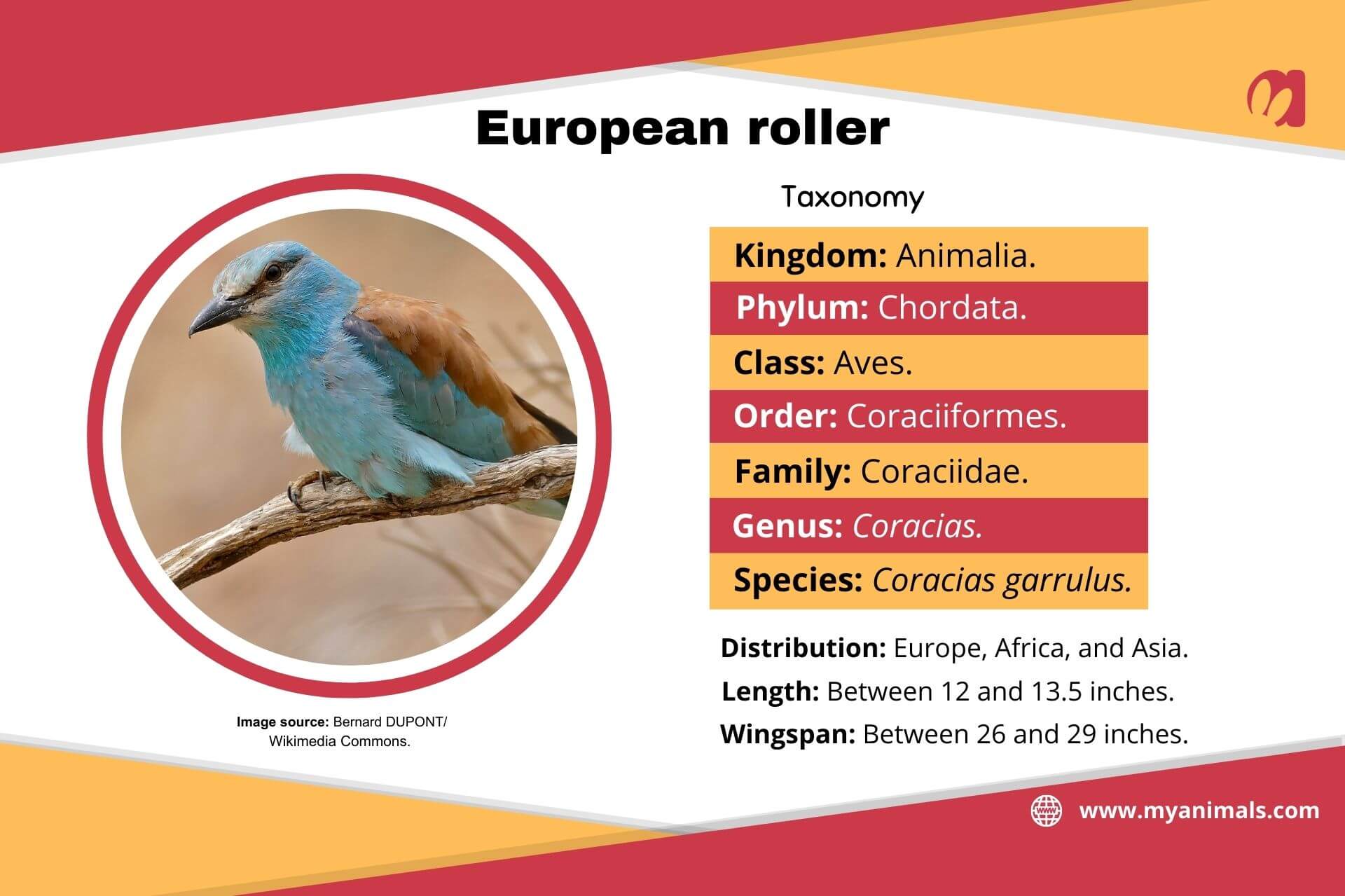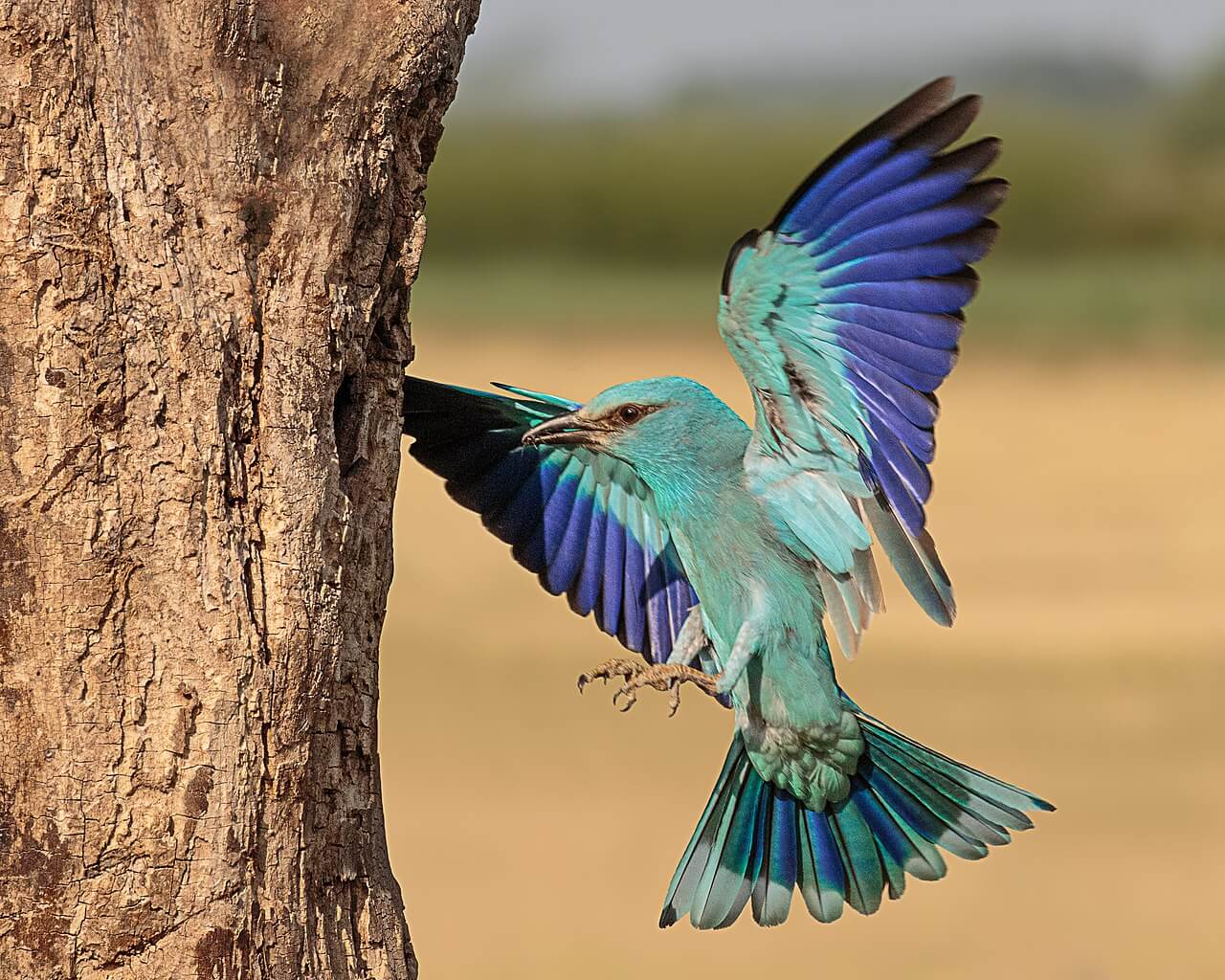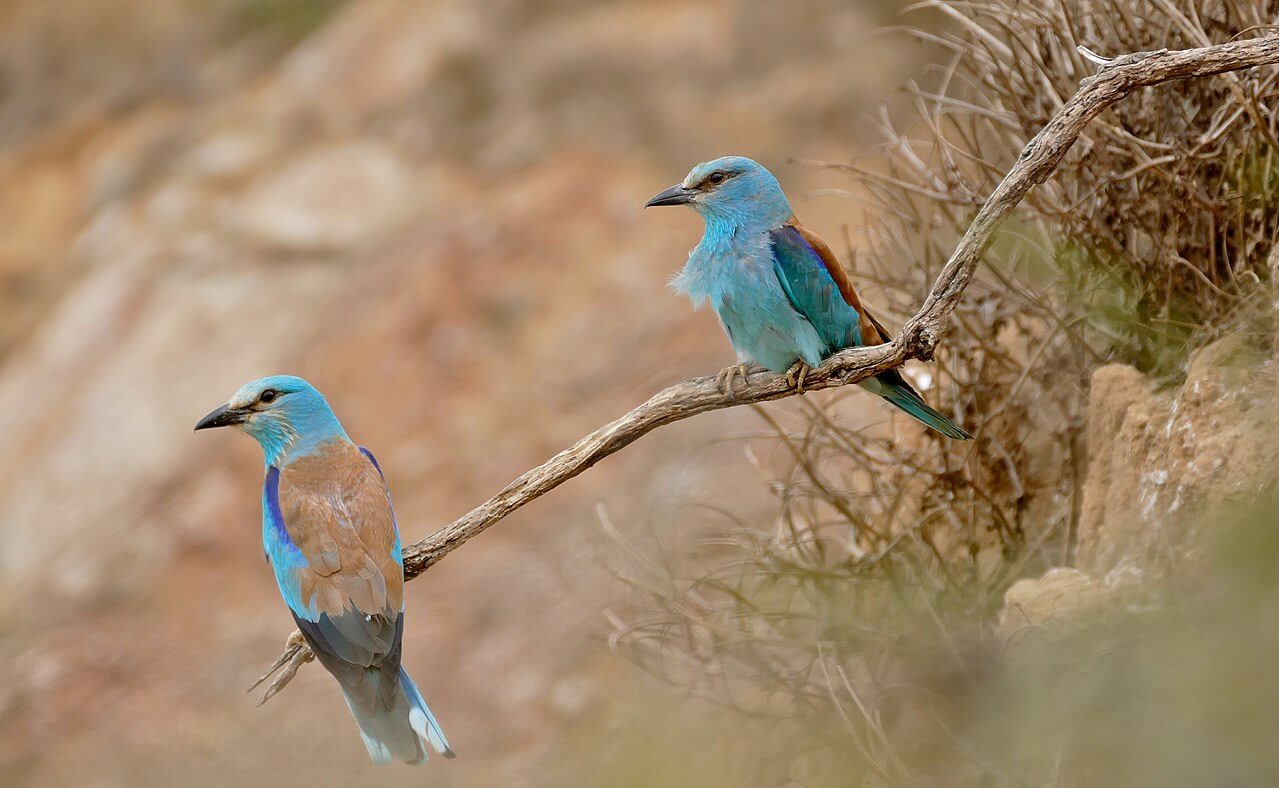The European Roller: A Bird with an Eye-Catching Appearance


Written and verified by the biologist Georgelin Espinoza Medina
In Europe, there’s a very colorful bird with blue and brown plumage, popularly known as the “European roller”. In addition to being beautiful, it stands out for its unique song, a loud and noisy call. It’s also a migratory animal with a generalist diet, which you’ll appreciate knowing about in depth.
It belongs to the order Coraciiformes and to the family Coraciidae, in which only two genera are included: Coracias, with 9 species, and Eurystomus, with 4. Its scientific name is Coracias garrulus. In this article, we’ll bring you a complete description of this striking and interesting bird. Keep reading to learn about it in its natural environment in detail!
Where does the European Roller live?
The European Roller is found in Europe, parts of sub-Saharan Africa, and the northwestern region. It can also be found in central Asia. It lives in temperate or warm areas with trees, up to 2400 meters above sea level, as the upper limit of altitude. Although it prefers low, open spaces and also steppes for breeding.
Characteristics of Coracias garrulus

The European roller is a very colorful bird, which attracts attention with its colorful plumage. It has bluish tones, with some brown parts, such as the back. Its head has a greenish-blue color, while the rump and scapular feathers are of a more intense blue. At the same time, the end of the flight feathers is black, which makes a good contrast -with the rest of the colors- when the bird is in flight.
Its shades are very striking. In addition to making it a beautiful specimen, they allow for easy identification.
Regarding its size, it barely reaches 12 to 13 inches in length and 26 to 29 in wingspan, that is, the measure that goes from one wing to the other when they’re extended. These data are provided by the Spanish Ornithological Society (SEO-BirdLife). According to this source, the Coracias garrulus is considered a medium-sized bird.
Its appearance is robust and it has a large head in relation to the rest of the body. In addition, the European Roller has a strong black bill and yellow legs. Young specimens do differ from adults, as their feathers are less intensely colored.
There’s no sexual dimorphism between the sexes, as both are very similar in size and coloration. However, in an E3S Web of Conferences study, published in 2021, the authors detail that males and females of this species are different in terms of the intensity of the color of their plumage.
In this regard, they claim that female rollers are paler than male rollers.
Subspecies
There are two subspecies or types of European rollers, which are the following:
- Coracias garrulus garrulus garrulus, the nominal species
- Coracias garrulus semenowi
The song of the European roller
The sound emitted by these animals is characteristic: A loud and noisy “rak cra” song. They usually emit their vocalizations during courtship, when they sense danger, and in other interactions with other species.
Feeding

The European roller is an omnivorous, generalist, and opportunistic bird. Their diet depends on the abundance and availability of food in the environment.
They generally consume a wide variety of insects and other invertebrates. However, they occasionally include small vertebrates and fruits. They may also include dead animals, such as road kill. As you’ll see, the diet includes a variety of creatures. Among them, the following stand out:
- Butterflies and moths
- Grasshoppers and crickets
- Earthworms
- Dragonflies
- Beetles
- Lizards
- Small snakes
- Slugs and snails
- Amphibians
- Rodents.
These birds usually forage during the day or at dusk, but on certain occasions, they may forage at night.
Chicks consume animal prey in its entirety. This is detailed in a publication of the journal Ardeola. It also states that their diet is dominated by arthropods. Among them, the following can be mentioned:
- Orthoptera
- Coleoptera
- Hymenoptera
- Isopods
Another study published in the journal IBIS mentions that European roller hatchlings ingest mostly grasshoppers and crickets, while adults prefer beetles.
Hunting methods are also varied and efficient. This bird usually searches for prey from the top of a perch and then, if it spots food to catch, flies to the ground or grass without landing in order to capture it. Likewise, it can grab prey in flight, among other behaviors. They also take advantage of the rain to search for earthworms on the ground.
Reproduction

These caracaras are monogamous birds. However, a study conducted by a student at the University of Córdoba details that they may exhibit alternative reproductive behaviors, such as paternity outside of the pair or parasitism toward other nests of the same species.
The birds select a nesting territory and mark it with characteristic flights into the air and hoarse cries. The displays are performed by males, but females may accompany them.
It’s also common to observe the feeding of females by males, even days before laying and until it ends. On fewer occasions, the opposite takes place. Mating occurs a few days before the laying of eggs (about 3 to 5 days).
The nest
The nest in these birds consists of holes, either in natural or anthropogenic cliffs. They also use holes in trees. In Europe, they like to lay their eggs in holes in pine and oak trees.
To be more precise, in the Iberian Peninsula, they do so in almond, poplar, palm, and cork oak trees. These holes are usually 12 to 20 inches deep and they use the same place for several years.
The eggs
Several eggs -from 3 to 7- make up the clutch of the European Roller. These are white, round to ellipsoid in shape, and have a smooth, shiny surface. According to a 2023 publication in the journal Ecosystem Transformation, they have an average size of 13 by 10.5 inches and weigh 3.03 pounds. Incubation lasts about 17 to 20 days.
The hatchlings
The chicks are born with their eyes closed and weigh an average of 14.77 grams, with values ranging from 13 to 17 pounds, 5 ounces. On day 7, they open their eyes, and at 23 or 24, their bodies are covered with contour feathers. Therefore, they can fly from this moment on.
They acquire full development between 26 and 27 days of life and weigh around 4.9 to 5.3 ounces. In this period, they’re ready to leave the nest.
Parental care
In this species, there’s parental care by both sexes. The parents are in charge of incubating and feeding their young. The males guard the territory of both European rollers and other bird species.
Females incubate the eggs during the night and, during the day, both parents take turns incubating the eggs. After the chicks hatch, both parents provide the food.
These birds are very concerned about their young, so much so that the entire family stays close to the nest site – between 330 and 765 meters away – for up to two weeks after the chicks leave the nest. This occurs while the chicks finish learning foraging and catching techniques.
The conservation status of the European Roller
This ruddy-headed goose isn’t endangered. The International Union for Conservation of Nature (IUCN), classifies it as “Least Concern”, since 2015. However, in 2005, 2008, and 2012, it was listed as “near threatened”.
Currently, populations are in a declining state, although not in alarming numbers so as to put its survival at a global level at risk. Despite this, the Spanish Ornithological Society declares it an “endangered bird.”
Threats affecting its life include the loss of breeding and nesting habitats, as well as the use of pesticides that decrease the availability of insects (its main food). It’s also at risk due to illegal hunting in certain regions.
Colorful plumage, a unique song, and parental care
To conclude, the European Roller is very striking, not only due to its colorful and showy plumage, but also thanks to its deep and distinctive song. This bird cares for its young with care and dedication, and its parental role is well distributed among both sexes.
At present, it’s not in danger of extinction globally, but the decline of its populations is of concern in some localities. Therefore, conservation actions may be necessary, sooner rather than later, to help the European roller to perpetuate itself over time.
In Europe, there’s a very colorful bird with blue and brown plumage, popularly known as the “European roller”. In addition to being beautiful, it stands out for its unique song, a loud and noisy call. It’s also a migratory animal with a generalist diet, which you’ll appreciate knowing about in depth.
It belongs to the order Coraciiformes and to the family Coraciidae, in which only two genera are included: Coracias, with 9 species, and Eurystomus, with 4. Its scientific name is Coracias garrulus. In this article, we’ll bring you a complete description of this striking and interesting bird. Keep reading to learn about it in its natural environment in detail!
Where does the European Roller live?
The European Roller is found in Europe, parts of sub-Saharan Africa, and the northwestern region. It can also be found in central Asia. It lives in temperate or warm areas with trees, up to 2400 meters above sea level, as the upper limit of altitude. Although it prefers low, open spaces and also steppes for breeding.
Characteristics of Coracias garrulus

The European roller is a very colorful bird, which attracts attention with its colorful plumage. It has bluish tones, with some brown parts, such as the back. Its head has a greenish-blue color, while the rump and scapular feathers are of a more intense blue. At the same time, the end of the flight feathers is black, which makes a good contrast -with the rest of the colors- when the bird is in flight.
Its shades are very striking. In addition to making it a beautiful specimen, they allow for easy identification.
Regarding its size, it barely reaches 12 to 13 inches in length and 26 to 29 in wingspan, that is, the measure that goes from one wing to the other when they’re extended. These data are provided by the Spanish Ornithological Society (SEO-BirdLife). According to this source, the Coracias garrulus is considered a medium-sized bird.
Its appearance is robust and it has a large head in relation to the rest of the body. In addition, the European Roller has a strong black bill and yellow legs. Young specimens do differ from adults, as their feathers are less intensely colored.
There’s no sexual dimorphism between the sexes, as both are very similar in size and coloration. However, in an E3S Web of Conferences study, published in 2021, the authors detail that males and females of this species are different in terms of the intensity of the color of their plumage.
In this regard, they claim that female rollers are paler than male rollers.
Subspecies
There are two subspecies or types of European rollers, which are the following:
- Coracias garrulus garrulus garrulus, the nominal species
- Coracias garrulus semenowi
The song of the European roller
The sound emitted by these animals is characteristic: A loud and noisy “rak cra” song. They usually emit their vocalizations during courtship, when they sense danger, and in other interactions with other species.
Feeding

The European roller is an omnivorous, generalist, and opportunistic bird. Their diet depends on the abundance and availability of food in the environment.
They generally consume a wide variety of insects and other invertebrates. However, they occasionally include small vertebrates and fruits. They may also include dead animals, such as road kill. As you’ll see, the diet includes a variety of creatures. Among them, the following stand out:
- Butterflies and moths
- Grasshoppers and crickets
- Earthworms
- Dragonflies
- Beetles
- Lizards
- Small snakes
- Slugs and snails
- Amphibians
- Rodents.
These birds usually forage during the day or at dusk, but on certain occasions, they may forage at night.
Chicks consume animal prey in its entirety. This is detailed in a publication of the journal Ardeola. It also states that their diet is dominated by arthropods. Among them, the following can be mentioned:
- Orthoptera
- Coleoptera
- Hymenoptera
- Isopods
Another study published in the journal IBIS mentions that European roller hatchlings ingest mostly grasshoppers and crickets, while adults prefer beetles.
Hunting methods are also varied and efficient. This bird usually searches for prey from the top of a perch and then, if it spots food to catch, flies to the ground or grass without landing in order to capture it. Likewise, it can grab prey in flight, among other behaviors. They also take advantage of the rain to search for earthworms on the ground.
Reproduction

These caracaras are monogamous birds. However, a study conducted by a student at the University of Córdoba details that they may exhibit alternative reproductive behaviors, such as paternity outside of the pair or parasitism toward other nests of the same species.
The birds select a nesting territory and mark it with characteristic flights into the air and hoarse cries. The displays are performed by males, but females may accompany them.
It’s also common to observe the feeding of females by males, even days before laying and until it ends. On fewer occasions, the opposite takes place. Mating occurs a few days before the laying of eggs (about 3 to 5 days).
The nest
The nest in these birds consists of holes, either in natural or anthropogenic cliffs. They also use holes in trees. In Europe, they like to lay their eggs in holes in pine and oak trees.
To be more precise, in the Iberian Peninsula, they do so in almond, poplar, palm, and cork oak trees. These holes are usually 12 to 20 inches deep and they use the same place for several years.
The eggs
Several eggs -from 3 to 7- make up the clutch of the European Roller. These are white, round to ellipsoid in shape, and have a smooth, shiny surface. According to a 2023 publication in the journal Ecosystem Transformation, they have an average size of 13 by 10.5 inches and weigh 3.03 pounds. Incubation lasts about 17 to 20 days.
The hatchlings
The chicks are born with their eyes closed and weigh an average of 14.77 grams, with values ranging from 13 to 17 pounds, 5 ounces. On day 7, they open their eyes, and at 23 or 24, their bodies are covered with contour feathers. Therefore, they can fly from this moment on.
They acquire full development between 26 and 27 days of life and weigh around 4.9 to 5.3 ounces. In this period, they’re ready to leave the nest.
Parental care
In this species, there’s parental care by both sexes. The parents are in charge of incubating and feeding their young. The males guard the territory of both European rollers and other bird species.
Females incubate the eggs during the night and, during the day, both parents take turns incubating the eggs. After the chicks hatch, both parents provide the food.
These birds are very concerned about their young, so much so that the entire family stays close to the nest site – between 330 and 765 meters away – for up to two weeks after the chicks leave the nest. This occurs while the chicks finish learning foraging and catching techniques.
The conservation status of the European Roller
This ruddy-headed goose isn’t endangered. The International Union for Conservation of Nature (IUCN), classifies it as “Least Concern”, since 2015. However, in 2005, 2008, and 2012, it was listed as “near threatened”.
Currently, populations are in a declining state, although not in alarming numbers so as to put its survival at a global level at risk. Despite this, the Spanish Ornithological Society declares it an “endangered bird.”
Threats affecting its life include the loss of breeding and nesting habitats, as well as the use of pesticides that decrease the availability of insects (its main food). It’s also at risk due to illegal hunting in certain regions.
Colorful plumage, a unique song, and parental care
To conclude, the European Roller is very striking, not only due to its colorful and showy plumage, but also thanks to its deep and distinctive song. This bird cares for its young with care and dedication, and its parental role is well distributed among both sexes.
At present, it’s not in danger of extinction globally, but the decline of its populations is of concern in some localities. Therefore, conservation actions may be necessary, sooner rather than later, to help the European roller to perpetuate itself over time.
All cited sources were thoroughly reviewed by our team to ensure their quality, reliability, currency, and validity. The bibliography of this article was considered reliable and of academic or scientific accuracy.
- Avilés, J. M. (2010). Carraca europea – Coracias garrulus. En: Enciclopedia Virtual de los Vertebrados Españoles. Salvador, A., Bautista, L. M. (Eds.). Museo Nacional de Ciencias Naturales, Madrid. https://digital.csic.es/bitstream/10261/110641/1/corgar_v3.pdf
- Avilés, J., & Parejo, D. (1997). Dieta de los pollos de carraca (Coracias garrulus) en una zona Mediterranea (Extremadura, suroeste de España). Ardeola, 44(2), 235-237. https://www.ardeola.org/es/volumenes/442/articulos/235-237/?stc=ok
- BirdLife International. (2019). Coracias garrulus. The IUCN Red List of Threatened Species 2019: e.T22682860A154424974. https://www.iucnredlist.org/species/22682860/154424974
- Catry, I., Sampaio, A., Silva, M., Moreira, F., Franco, A., & Catry, T. (2018). Combining stable isotope analysis and conventional techniques to improve knowledge of the diet of the European Roller Coracias garrulus. IBIS, 161(2), 272-285. https://onlinelibrary.wiley.com/doi/10.1111/ibi.12625
- Malovichko, L., Poddubnaya, N., Akiñova, K., & Eltosa, L. (2021). Reproductive behavior of the european roller (Coracias garrulus Linnaeus, 1758). E3S Web of Conferences, 265, 01007. https://www.e3s-conferences.org/articles/e3sconf/abs/2021/41/e3sconf_apeem2021_01007/e3sconf_apeem2021_01007.html
- Malovichko, L., Poddubnaya, N., & Kulakov, D. (2023). Ecology and reproductive biology of the European Roller Coracias garrulus L., 1758 in Stavropol Region. Ecosystem Transformation, 6(1), 1–21. https://cyberleninka.ru/article/n/ecology-and-reproductive-biology-of-the-european-roller-coracias-garrulus-l-1758-in-stavropol-region/viewer
- Sánchez Tójar, A. (2013). Estrategias reproductivas alternativas en la carraca europea (Coracias garrulus): cuando la genética se convierte en herramienta indispensable. [Tesis de Maestría, Universidad de Córdoba]. https://helvia.uco.es/handle/10396/12749
- Sociedad Española de Ornitología. (s.f.). Carraca europea. Consultado el 04 de junio de 2023. https://seo.org/ave/carraca-europea/
This text is provided for informational purposes only and does not replace consultation with a professional. If in doubt, consult your specialist.








